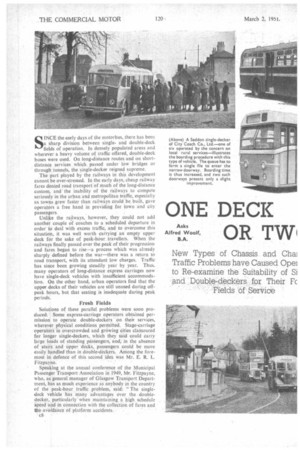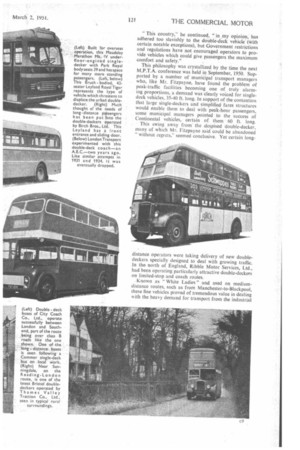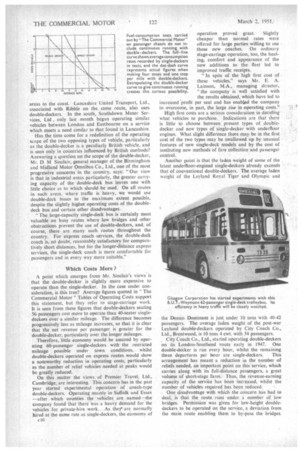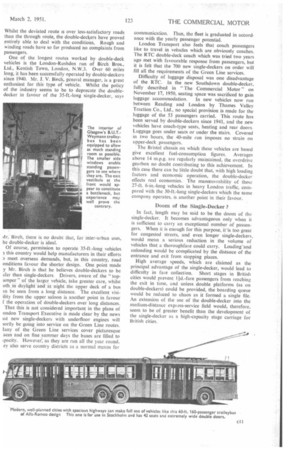ONE DECK
Page 46

Page 47

Page 48

Page 49

If you've noticed an error in this article please click here to report it so we can fix it.
Asks
Alfred Woolf, OR rrvtrl
B.A.
New Types of Chassis and Cha] Traffic Problems have Caused Opei to Re-examine the Suitability of Si and Double-deckers for Their Fc Fields of Service
SINCE the early days of the motorbus, there has been a sharp division between singleand double-deck fields of operation. In densely populated areas and wherever a heavy volume of traffic offered, double-deck buses were used. On long-distance routes and on shortdistance services which passed under low bridges or through tunnels, the single-decker reigned supreme.
The part played by the railways in this development cannot be over-stressed. In the early days, cheap railway fares denied road transport of much of the long-distance custom, and the inability of the railways to compete seriously in the urban and metropolitan traffic, especially as towns grew faster than railways could be built, gave operators a free hand in providing for town and city passengers Unlike the railways, however, they could not add another couple of coaches to a scheduled departure in order to deal with excess traffic, and to overcome this situation, it was well worth carrying an empty upper deck for the sake of peak-hour travellers. When the railways finally passed over the peak of their progression and fares began to rise—a process which was already sharply defined before the war—there was a return to road transport, with its attendant low charges. Traffic has since been growing steadily year by year. Thus, many operators of long-distance express carriages now have single-deck vehicles with insufficient accommodation. On the other hand, urban operators find that the upper decks of their vehicles are still unused during offpeak hours, but that seating is inadequate during peak periods.
Fresh Fields Solutions of these parallel problems were soon produced. Some express-carriage operators obtained permission to operate double-deckers on their services, wherever physical conditions permitted. Stage-carriage operators in overcrowded and growing cities clamoured for longer single-deckers, which they said could carry large loads of standing passengers, and, in the absence of stairs and upper decks, passengers could be more easily handled than in double-deckers. Among the foremost in defence of this second idea was Mr. E. R. L. Fitzpayne.
Speaking at the annual conference of the Municipal Passenger Transport Association in 1949, Mr. Fitzpayne, who, as general manager of Glasgow Transport Department, has as much experience as anybody in the country of the peak-hour traffic problem, said: "The singledeck vehicle has many advantages over the doubledecker, particularly when maintaining a high schedule speed and in connection with the collection of fares and the avoidance of platform accidents.
CS "This country,' he continued, "in my opinion, has adhered too slavishly to the double-deck vehicle (With certain notable exceptions), but Government restrictions and regulations have not encouraged operators to provide vehicles which could give passengers the maximum comfort and safety."
This philosophy was crystallized by the time the next M.P.T.A. conference was held in September, 1950. Supported by a number of municipal transport managers who, like Mr. Fitzpayne, have found the problem of peak-traffic facilities becoming one of truly alarming proportions, a demand was clearly voiced for singledeck vehicles, 35-40 ft. long. In support of the contention that large single-deckers and simplified fares structures would enable them to deal with peak-hour passengers, some municipal managers pointed to the success of Continental vehicles, certain of them 60 ft. long.
This swing away from the despised double-decker, many of which Mr. Fitzpayne said could be abandoned " without regrets," seemed conclusive. Yet certain long distance operators were taking delivery of new doubledeckers specially designed to deal with growing traffic. In the. north of England, Ribble Motor Services, Ltd., had been operating particularly attractive double-deckers on limited-stop and coach routes.
Known as "White Ladies" and used on mediumdistance routes, such as from Manchester-to-Blackpool, these fine vehicles proved of tremendous value in dealing with the heavy demand for transport from the industrial areas to the coast. Lancashire United Transport, Ltd., associated with Ribble on the same route, also uses double-deckers. In the south, Southdown Motor Services, Ltd, only last month began operating similar vehicles between London and Eastbourne on a service which meets a need similar to that found in Lancashire.
Has the time come for a redefinition of the operating scope of the two opposing types of vehicle, particularly as the double-decker is a peculiarly British vehicle, and is seen only in cotintries influenced by British methods? Answering a question on the scope of the double-decker, Mr. D M Sinclair, general manager of the Birmingham and Midland Motor Omnibus Co., Ltd., one of the most progressive concerns in the country, says: Our view is that in industrial areas particularly, the greater carrying capacity of the double-deck bus leaves one with little choice as to which should be used. On all routes in such areas, where traffic is heavy, we would use double-deck buses to the maximum extent possible, despite the slightly higher operating costs of the doubledeck bus and certain other disadvantages.
"The large-capacity single-deck bus is certainly most valuable on busy routes where low bridges and other obstructions prevent the use of double-deckers, and, of course, there are many such routes throughout the country. For express coach services, the double-deck coach is, no doubt, reasonably satisfactory for comparatively short distances, but for the longer-distance express services, the single-deck coach is more comfortable for passengers and in every way more suitable."
Which Costs More ?
A point which emerges from Mr. Sinclair's viewssis that the double-decker is slightly more expensive to operate than the single-decker. In the case under consideration, is this true? Average figures quoted in " The Commercial Motor" Tables of Operating Costs support this statement, but they refer to stage-carriage work. It is seen from these figures that double-deckers seating 56 passengers cost more to operate than 40-seater singledeckers over a similar mileage. The difference becomes progressively less as mileage increases, so that it is clear that the net revenue per passenger is greater for the double-decker, particularly over the longer mileages.
Therefore, little economy would be assured by operating 60-passenger single-deckers with the restricted mileage possible under town conditions, whilst double-deckers operated on express routes would show a noteworthy reduction in operating costs, particularly as the number of relief vehicles needed at peaks would be greatly reduced.
On this matter the views of Premier Travel, Ltd., Cambridge, are interesting. This concern has in the past year started experimental operation of coach-type double-deckers. Operating mainly in Suffolk and Essex —after which counties the vehicles are named—the company found that there was a heavy demand for the vehicles for private-hire work.. As they' are normally hired at the same rate as single-deckers, the economy of c10 operation proved great. Slightly cheaper than normal rates were offered for large parties willing to use these new coaches. On ordinary stage-carriage operation, too, the heating, comfort and appearance of the new additions to the fleet led to improved traffic receipts.
"In spite of the high first cost of these vehicles," says Mr. E. A. Lainson, MA., managing director, "the company is well satisfied with the results obtained, which have led to increased profit per seat and has enabled the company to overcome, in part, the large rise in operating costs."
High first costs are a serious consideration in deciding' what vehicles to purchase. Indications are that there is little to choose between present types of doubledecker and new types of single-decker with underfloor engines. What slight difference there may be in the first cost of the two types may be swallowed up by unusual features of new single-deck models and by the cost of instituting new methods of fare collection and passenger control.
Another point is that the laden weight of some of the latest underfloor-engined single-deckers already exceeds that of conventional double-deckers. The average laden weight of the Leyland Royal Tiger and Olympic and the Dennis Dominant is just under 10 tons with 40-42 passengers. The average laden weight of the post-war Leyland double-deckers operated by City Coach Co., Ltd., Brentwood. is 10 tons 4 cwt. with 54 passengers.
City Coach Co., Ltd., started operating double-deckers on its London-Southend route early in 1947. One double-decker is run every hour, whilst the remaining three departures per hour are single-deckers. This arrangement has meant a reduction in the number of reliefs needed, an important point on this service, which carries along with its full-distance passengers, a great volume of short-stage fares. Thus, the revenue-earning capacity of the serviee has been increased, whilst the number of vehicles required has been reduced.
One disadvantage with which the concern has had to deal, is that the route runs under a number of low bridges. Permission was given for low-height doubledeckers to be operated on the service, a deviation from the main route enabling them to by-pass the bridges. Whilst the deviated route is over less-satisfactory roads than the through route, the double-deckers have proved entirely able to deal with the conditions. Rough and winding roads have so far produced no complaints from passengers.
One of the longest routes worked by double-deck vehicles is the London-Rushden run of Birch Bros., Ltd., Kentish Town, London, N.W.3. Over 60 miles long, it has been successfully operated by double-deckers since 1940. Mr. J. V. Birch, general manager, is a great enthusiast for this type of vehicle. Whilst the policy of the industry seems to be to deprecate the doubledecker in favour of the 35-ft.-long single-decker, says Ar. Birch, there is no doubt that, for inter-urban uses, he double-decker is ideal.
Of course, permission to operate 35-ft.-long vehicles 1 this country would help manufacturers in their efforts meet overseas demands, but, in this country, road onditions favour the shorter design. One point made y Mr. Birch is that he believes double-deckers to be ifer than single-deckers Drivers, aware of the " topamper of the larger vehicle, take greater care, whilst oth in daylight and at night the upper deck of a bus in be seen from a long distance. The excellent visiility from the upper saloon is another point in favour f the operation of double-deckers over long distances. That this is not considered important in the plans of ondon Transport Executive is made clear by the news iat new single-deckers with underfloor engines will iortly be going into service on the Green Line routes. (any of the Green Line services cover picturesque aces and on fine summer days the buses are filled to [pacity. However', as they are run all the year round. ey also serve country districts as a normal means for
communication. Ihus, the fleet is graduated in accordance with the yearly passenger potential.
London Transport also feels that coach passengers like to travel in vehicles which are obviously coaches.
The RTC double-deck coach which was tried two years ago met with favourable response from passengers, but it is felt that the 700 new single-deckers on order will fill all the requirements of the Green Line services.
Difficulty of luggage disposal was one disadvantage of the RTC. In the new Southdown double-decker, fully described in "The Commercial Motor" on November 17, 1950, seating space was sacrificed to gain luggage accommodation. In new vehicles now run between Reading and London by Thames Valley Traction Co., Ltd., no special provision is made for the luggage of the 53 passengers carried. This route has been served by double-deckers since 1941, and the new vehicles have coach-type seats, heating and rear doors Luggage goes under seats or under the stairs. Covered in two hours, the 40-mile run imposes no strain on upper-deck .passengers.
The Bristol chassis on which these vehicles are based give excellent fuel-consumption figures. Averages
above 14 m.p.g are regularly maintained, the overdrive
gearbox no doubt contributing to this achievement. In this case there can be little doubt that, with high loading factors and economic operation, the double-decker effects real economies. The manceuvrability of these 27-ft. 6-in.-long vehicles in heavy London traffic, compared with the 30-ft.-long single-deckers which the same company operates, is another point in their favour.
Doom of the Single-Decker ?
In fact, length may be said to be the doom of the single-decker. It becomes advantageous only when it is sufficient to carry an exceptional number of passengers. When it is enough for this purpose, it-is too great for congested streets, and even longer single-deckers. would mean a serious reduction in the volume of vehicles that a thoroughfale could carry. Loading'and unloading would be complicated by the distance of the entrance and exit from stopping places.
High average speeds, which are claimed as the principal advantage of the single-decker, would lead to difficulty in fare collection. Short stages in British cities would prevent lid.-fare passengers from reaching the exit in time, and unless double platforms (as on double-deckers) could be provided, the boarding queue would be reduced to chaos as it formed a single file. An extension of the use of the double-decker into the medium-distance expless-service field would, therefore, seem to be of greater benefit than the development of the single-decker as a high-capacity stage carriage for British cities.




























































































